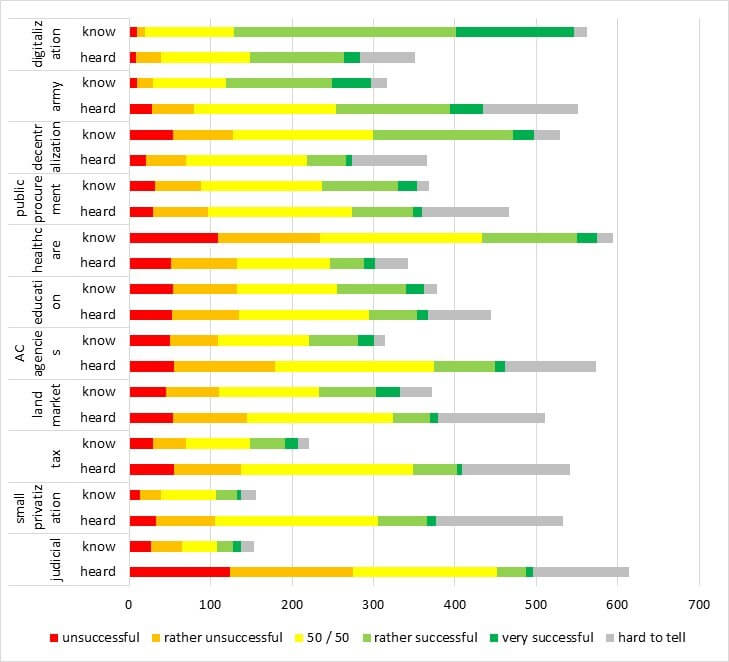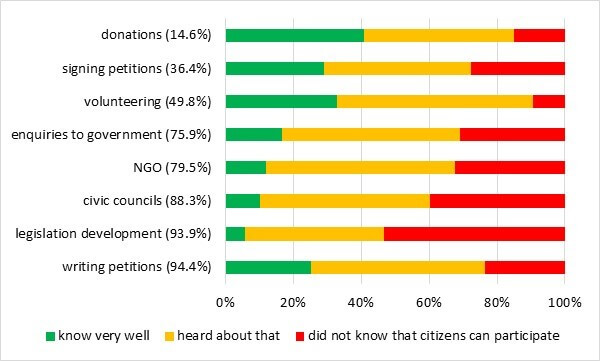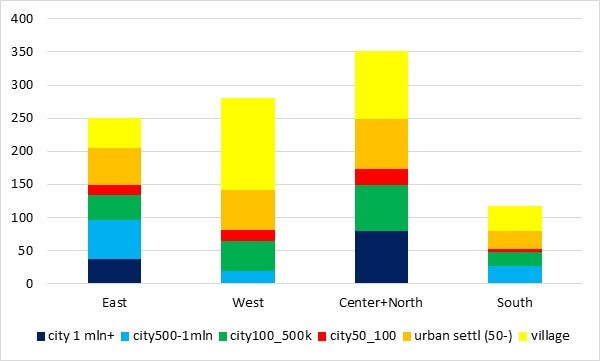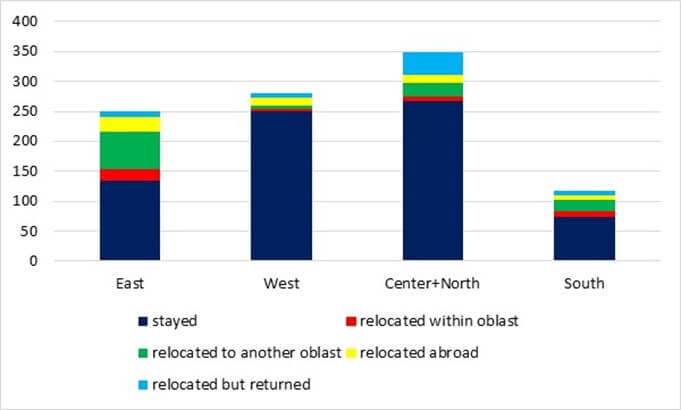In April 2023 Factum Group polling company surveyed 1000 Ukrainians asking them about their awareness about reforms, their opinion on importance and success of reforms and their participation in several types of civic activities. Based on this data, we estimate which factors impact perception of Ukrainians on the success of reforms and their intent to participate in civic activities such as signing petitions or volunteering.
The main results
- The most important reforms in view of Ukrainians are lowering corruption, healthcare, judicial, and education reforms. The list of important reforms suggested by respondents is very similar to the one compiled by our researchers prior to the survey.
- People who participate in civic activities are more aware about reforms. People participating in civic councils are more aware of decentralization, those drafting legislation – of judicial reform, and NGO participants are more likely to know about procurement reform and small privatization.
- People who participate in certain civic activities more likely estimate them as effective. In a similar spirit, people who are more aware about reforms are more likely to estimate them as successful (healthcare and small privatization are exceptions, with more awareness implying lower estimates of success of these reforms).
- The most certain predictor of plans to participate in a civic activity is current participation in it. Awareness or estimates of effectiveness do not play a decisive role, while personal characteristics are significant for a small number of activities. Thus, people from poorer households less likely plan to donate, write petitions or participate in activities of government agencies while employed people more likely plan to donate and write petitions.
- Our results show that often people do not understand what reforms are about (e.g. many name higher salaries or provision of jobs as reforms). Therefore, more refined surveys measuring awareness on reforms and civic activities are advised.
Data description
The survey was performed using a representative online panel. 15% of respondents relocated within Ukraine and 6% relocated abroad. An overview of the answers related to corruption can be found here, an overview of responses about reforms – here. Summary statistics for the sample can be found in Annex 1.
The scheme of reform questions is provided in Table 1. Note that only people who know at least something about a reform were asked to evaluate its importance and success. Table 2 presents the scheme for civic engagement questions. People who currently do not participate in civic activities were asked of their awareness about the opportunities for participation in them (e.g. whether a person knows exactly how to join an NGO, has heard something about it or did not know that citizens can participate in it). People who do not participate in a civic activity today were also asked whether they participated in it before the full-scale invasion, while all the respondents were asked about their plans to join civic activities.
Table 1. Scheme of reform questions
| Please name three most important reforms (open question) | |
| Expected reform results (semi-open question) | |
| Obstacles for implementation of reforms (semi-open question) | |
| Awareness about 11 reforms (closed question) | |
| I know about this reform / heard of it | I’ve never heard about it |
| How important is this reform? (1-5 scale)
How successful is this reform (1-5 scale) |
|
Note: green cells indicate questions asked of entire sample, yellow cells indicate questions asked of a part of the sample
Table 2. Scheme of civic engagement questions
| How effective are the following activities? (1-5 scale). 8 activities were evaluated: participation in an NGO, volunteering, creating petitions, signing petitions, participation in civic councils or open meetings of government bodies, participation in drafting legislation, sending enquiries to government agencies, and donating. | ||
| Do you plan to participate in the following activities during the next 6 months? | ||
| Do you participate in the following activities during the full-scale war? | ||
| yes | no | hard to tell |
How did the war impact your involvement in a specific activity?
|
Were you involved in these activities before the war? | |
| Do you know how to participate in these activities? (know well / heard something/ don’t know) | ||
Note: green cells indicate questions asked of entire sample, yellow cells indicate questions asked of a part of the sample
Results: reforms
Figure 1 provides the list of reforms which our respondents named the most important. This “rating” largely coincides with the reforms named by respondents in the open question. Namely, the first four reforms in both lists are identical – anti-corruption, healthcare, judicial system and education.
Fifth place in the closed question and tenth in the open question belongs to the pension reform.
Our respondents did not specify what they imply by pension reform but probably the majority implied an increase in pensions, since quite many respondents provided an increase of salaries or social support as answers to this question. These are not reforms but rather issues important for Ukrainians. In the same spirit, quite many respondents answered to this question that Ukraine needs to win the war or restore peace. As we discuss below, our estimates indeed suggest that people usually list in the open question the areas that are the most problematic in their view.
Figure 1. Answers to the question “Which of these spheres should be reform priorities?
Note: respondents could select up to 5 spheres
Our previous research also showed poor understanding of the nature of reforms. This suggests that more explanation on what a reform is and what certain reforms imply is needed. Indeed, as shown in Figure 2, much less people “know” about some reform than “have heard” of it. This is especially true for judicial reform, tax reform and small privatization (these reforms also have the largest number of people who say that they don’t know anything about these reforms). At the same time, the majority of respondents believe that listed reforms are important or rather important (green and light green bars in Figure 2).
The answers about the success of reforms are much less “greener” (Figure 3). The most successful reform in view of Ukrainians is digitalization (61% of those who know about this reform or heard about it think that it is successful or rather successful). Other successful reforms were army reform (41%), decentralization (28%) and public procurement (24%). Judicial reform (9%), small privatization (15%) and tax reform (16%) are considered successful by the lowest shares of respondents.
Figure 2. How important are the following reforms, number of respondents among those who know about a certain reform or have heard of it
Note: total number of respondents is 1000, so the percentages can be easily calculated. The graph is sorted by the sum of people who say that a certain reform is important or rather important.
Figure 3. How successful are the following reforms, number of respondents among those who know about a certain reform or have heard of it
Note: the graph is sorted by number of people who consider certain reforms successful or rather successful. The most controversial reform is judicial (variation coefficient [1] of success estimates is 0.43, while the least controversial is digitalization with variation coefficient 0.23).
The majority of respondents believe that corruption is the main obstacle to reform, with the war with Russia in the second place and counteraction of vested interests in the third place (Figure 4). Consequently they expect reduction of corruption as the main reform result (Figure 5).
Figure 4. Obstacles to reforms (% of respondents who named a certain obstacle)
Note: this was a semi-open question but the share of respondents who provided their own answer was close to zero. Respondents could provide several answers
Figure 5. Expected reform results
Note: this was a semi-open question but the share of respondents who provided their own answer was very small. Respondents could provide several answers
Factors of reform awareness
Next, we analyse [2] which factors contribute to reform awareness (measured as the share of respondents saying that they know or heard about some reform as opposed to those who never heard about it). We are especially interested in how civic participation impacts reform awareness.
Providing donations, volunteering or signing petitions are three most frequent civic activities (see Figure 6), and being involved into them is associated with higher awareness practically on all of the reforms. This suggests that people who participate in civic activities are generally more involved in politics and thus more aware about the reforms. Some specific civic activities are associated with higher awareness of certain reforms. For example, people participating in civic councils or open meetings of government agencies are more aware of decentralization, those drafting legislation – of the judicial reforms, and those working for NGOs are more likely to know about procurement reform and small privatization.
This result is not surprising since many NGOs in Ukraine act as watchdogs and consider cases when the government buys or sells something; and a person involved with a government agency needs to study relevant legislative issues.
Employed people are more likely to know about procurement reform, digitalization and tax reform – perhaps because they use the respective services in their job.
Women are more likely to know about both education and healthcare reforms, which is in line with results of our previous research (probably women are more likely to take care of education of children and healthcare for a household). Expectedly, people with higher education and those who have children aged 7-12 are more likely to know about education reform too. Men are more likely to know about anti-corruption and army reforms.
People in cities of over 100 thousand people are more likely to say that they have heard about decentralization reform rather than know about it, which suggests that people from smaller communities or villages are more aware about the decentralization. This is an intuitive result, as well as lower awareness of people in cities about the land market reform: people in smaller and rural communities have a greater chance to have hands-on experience with land market or decentralization.
Views on success of reforms
Next we look at factors that impact a person’s belief that certain reform was successful [3]. First of all we observe that when a person names some reform as important (in the open question) she is less likely to evaluate this reform as successful: this is true for education, healthcare, decentralization, army, and judicial reforms. Perhaps in the open question people list problematic areas.
Another observation is that people who say that they know about some reform (as opposed to those who have heard about it) are more likely to believe that this reform is successful. This holds for all the considered reforms except for healthcare and small privatization, where “knowledge” increases the probability of evaluating this reform as unsuccessful. Note that in reality the healthcare reform was very successful – it changed the incentives of healthcare workers and started to increase efficiency of the Ukrainian healthcare system. However, if a person thinks that the success of healthcare reform is the availability of any healthcare service to anyone immediately, she may indeed be disappointed. This suggests that more refined questions measuring reform awareness should be considered in the surveys (as an example, CES survey1, survey2).
Younger people (younger than 35 or 45) are more positive about the majority of reforms and men are more likely to believe that army reform was a success. We could not find any systemic impact of educational attainment on the estimates of reform success.
People from the poorest category (those who have difficulties buying food) are more likely to believe that education reform was a success and less likely – that healthcare reform and digitalization was a success (they may be left behind by these reforms).
Relation of civic activities and success of reforms is presented in Table 3 (coloured cells present statistically significant results). Table 3 shows that generally people who participated in drafting legislation are more positive about the success of reforms (probably because they have more understanding on how complicated the process is or less inclined to criticize something to which they contributed), while volunteers, those who write petitions and donate are less likely to estimate reforms as successful (one reasons may be that they are partially doing the government job). Small privatization is the reform on which civic activists are more likely to have a defined opinion, and this opinion is mostly positive.
Table 3. Participation in civic activities and evaluation of success of reforms
| civic activities →
reforms ↓ |
NGOs | volunteering | writing petitions | signing petitions | civic councils | legislation development | enquiries to government agencies | donations |
| Tax | more | more | ||||||
| Education | less | less | ||||||
| Healthcare | ||||||||
| Digitalization | less | |||||||
| Decentralization | ||||||||
| AC agencies | less | more | ||||||
| Public procurement | less | more | less | |||||
| Army | less | less | less | less | ||||
| Land market | less | more | less | |||||
| Small privatization | more | less | more | more | more | less | ||
| Judicial | less | more |
Note: “more” means a person that participated in a certain civic activity is more likely to believe that a reform was successful; “less” – that the reform was not successful. For example, NGO members are more likely to think that small privatization was a success.
Results: civic engagement
Finally, we consider which factors affect civic engagement of a certain person. Figure 6 shows that today civic engagement is higher than before the full-scale war and is going to somewhat decline after the war. The most popular activities are donations and signing of petitions (perhaps because they are the least time-consuming). Quite a high share of Ukrainians (close to 50%) joined the volunteer movement. Involvement with the government is the least popular. After the war people who are currently involved into civic activities plan to somewhat scale down their activities, however, their share is small (less than 10%).
Figure 6. In which of these activities did you participate before the full-scale war, participate now or plan to participate in the next 6 months (% of respondents)
Note: blue bars show people who participated in civic activities prior to the war but quit with the start of the full-scale invasion (this share is quite small). The majority of people who were involved in some civic activities either kep their involvement at the same level or increased it.
Over a half of respondents participate in 2-3 civic activities during the war; about 20% participate in one activity and only a small share are involved in more than four activities. 7% of people did not participate in any of the activities during the war while before the war this share was nearly 76%. This implies that the full-scale invasion stimulated many Ukrainians to join civic activities, and mostly they joined the simples ones such as donating money.
We observe significant correlations between activities only with respect to “government-related” activities — participation in civic councils, drafting legislation, and writing petitions.
Figure 7. Awareness on civic activities
Note: percentages in parentheses show the share of respondents who currently do not participate in the stated activities
Figure 7 shows awareness of people about civic activities (as table 2 shows, this question was asked only of people who do not participate in the indicated civic activities). As we see, the lowest awareness is about activities related to interaction with officials – participation in civic oversight and legislation development. Figure 8 in its turn shows that people who participate in certain activities are more likely to say that these activities are effective (probably respondents evaluate usefulness of certain activities when answering this question); and the highest effectiveness is assigned to volunteering and donations – activities in which most people participate. Figure 9 shows that among “non-participants” people who are more aware about certain activities are more inclined to view them as effective.
Figure 8. People’s estimates of effectiveness of certain civic activities
Note: the question was asked of all respondents and formulated as “effectiveness”. Perhaps respondents talked about the usefulness of certain activities. “Yes” bars present answers of people who participate in certain activities, “no” – of those who do not participate.
Figure 9. Estimates of effectiveness of certain activities by awareness
Note: only those who currently do not participate in these activities were asked the question about awareness
Next we estimate the probability that a person plans to participate in certain civic activity in the next six months (note that only 18% do not plan to participate in any of the activities) [4]. We want to find out whether current participation, awareness of certain activities (for those who do not currently participate) and belief that certain activities are effective impacts people’s plans to start involvement in certain civic activities. We also look at people’s personal characteristics.
We find that people from poorer households less likely plan to donate, write petitions or participate in activities of government agencies. Employed people more likely plan to donate and write petitions and those who relocated within Ukraine more likely plan to sign petitions compared to those who stayed. Quite expectedly those who already participate in certain activities are more likely to participate in them in the future (Table 4).
Table 4. Estimated impact of current participation in certain activities on participation plans
| current →
plan ↓ |
NGOs | volunteering | writing petitions | signing petitions | councils | legislation development | enquiries | donating |
| NGOs | + | + | ||||||
| volunteering | + | + | ||||||
| writing petitions | – | + | – | |||||
| signing petitions | + | + | ||||||
| councils | – | + | + | |||||
| legislation development | – | + | ||||||
| enquiries | + | + | + | |||||
| donating | – | + |
Note: only significant results are shown. Rows: current participation, columns – planned participation. Green cells show that participation in some activities increases the probability to participate in certain activities in the future, yellow cells show a decrease in this probability. For example, people who are currently volunteers or NGO members are more likely to participate in these activities in the future and people who create petitions are less likely to participate in activities involving officials.
Awareness is either insignificant or decreases the probability of people planning to participate in certain activities, except for participation in law drafting (there, knowing makes people more likely to plan it). The reason may be that people who are currently not involved in certain activities do not plan to be involved, despite being aware of them. The belief that certain activities are effective (when it is significant) makes people more likely to plan to participate. The exception is signing petitions: people who think that this is effective less likely plan to participate in law drafting or sending enquiries to government agencies – probably because they do not want to spend much of their time on it (signing petitions is the least demanding form of civic activity).
Conclusions
The survey showed rather low awareness of people on both reforms and civic activities (perhaps if asked specific questions about the essence of reforms of activities this share would be even lower). Thus, both more effort on informing people and more refined surveys are needed since those who claim higher awareness are usually more positive about the success of reforms and effectiveness of civic activities. Generally Ukrainians believe that reforms are very important, with the highest importance placed on anti-corruption, healthcare and judicial reforms. Civic engagement increased much with the full-scale war and is going to somewhat decline in the future. The most popular civic activities are donating, signing petitions and volunteering. Involvement with the government, such as participation in legislation drafting or civic councils is the least popular.
Annex
Summary statistics of the sample
Figure A1. Gender/age distribution, number of respondents
Figure A2. Distribution by region and settlement type, number of respondents
Figure A3. Distribution by region and relocation
Figure A4. Distribution by education and employment
Figure A5. Distribution by two income classifications
Note: X axis shows share of household income spent on food and communal services
[1] To calculate variation coefficient (standard deviation divided by average) we used the ordered variable with 1=reform is not at all successful, 2=reform is somewhat successful, 3=50/50, 4=reform is rather successful; 5=reform is very successful and calculated averages and standard deviations for each of the reforms.
[2] The estimation was performed using probit regressions with civic engagement as variables of interest and demographic factors as controls.
[3] The estimation was performed using probit regression for each of the possible outcomes (successful, rather successful, 50/50, rather not successful, not successful), we also estimated an ordered probit model for the reform success. RHS variables included personal characteristics, participation in civic activities, person’s opinion on the importance of the reform in question and whether a person named this reform when answering an open question. Here and in the rest of the publication we report only statistically significant and robust results.
[4] We use probit regressions with variables of interest (current participation, awareness and estimates of effectiveness) and a number of demographic variables as controls.
Attention
The author doesn`t work for, consult to, own shares in or receive funding from any company or organization that would benefit from this article, and have no relevant affiliations

















